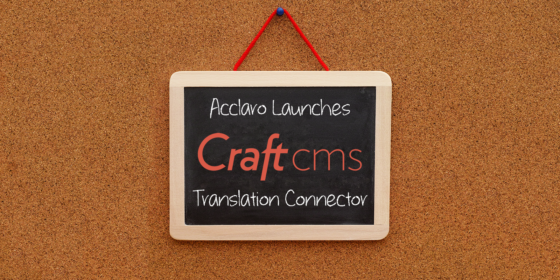
Engaging with global customers is more effective when multilingual content updates are fast and efficient.
Many B2B companies use a Content Management System (CMS) to create, manage, and publish digital content. They handle various types of content, such as text, images, videos, and audio, and organize them efficiently. All the content housed within your CMS–product descriptions, web content, marketing assets- works together to create a cohesive user experience, driving engagement and boosting conversions. However, with so much diverse content to localize, inconsistencies and delays in publishing multilingual content can make providing a reliable, engaging experience for global customers challenging.
That’s where CMS localization comes in. CMS localization involves creating processes to localize all the content inside your CMS efficiently. It removes roadblocks so every user can access the same quality, up-to-date content no matter where they are or what language they speak. The result? An improved global user experience that fosters conversions and boosts revenue without consuming excessive resources.
Here’s how to make that happen.
Important CMS requirements for localization success
Many content management systems include basic localization features, usually a multilingual plugin to translate content. However, true localization success requires much more than that.
To effectively create an engaging global user experience, you must set your systems up for success from the beginning, and that means choosing a CMS with localization-friendly features designed to support all aspects of the process. Translation is only one step—truly adapting your content for other cultures also requires:
- Updating images to make them more culturally relevant
- Updating display formats for dates, decimals, addresses, etc.
- Updating payment systems
- Adapting the layout and flow of the website to make it easy to read and navigate in the target market. For example, right-to-left languages like Arabic have different design requirements than English, which is read from left-to-right.
- Updating UI elements for cultural appropriateness
Look for a CMS with the following characteristics to ensure you’re using the best one for localizing your website.
Multilingual support
The most basic requirement for a localization-friendly CMS is that it supports updating content in multiple languages.
Flexible content authoring format
Choose a CMS with a content authoring format designed for easy content reuse and integration with a translation management system (TMS).
For example, the Darwin Information Typing Architecture (DITA) is great for content reuse and localization because it structures content modularly, making it easier to update, translate, and manage consistently across different formats and languages. Another alternative is a headless CMS for localization. A headless CMS separates content management from the front-end presentation, allowing easier integration with translation tools and more flexible content delivery across multiple platforms.
Regional customization options
Different countries have different conventions for displaying dates, times, addresses, numbers, and money. They may also have other payment systems and shipping options.
To avoid problems, choose a CMS for content localization that can display information in the expected formats for your target region and is compatible with the preferred local payment and shipping platforms.
Support for local device preferences
Different countries may have preferences for other types of devices and screen sizes. A CMS that supports responsive design and adapts to various devices ensures a consistent user experience across different regions.
While there isn’t one best CMS for content localization, enterprise-level systems like WordPress, Adobe Experience Manager, Craft, Contentful, and Drupal tend to offer the highest levels of localization support.
Common website and CMS localization issues and solutions
Localizing your CMS content for multiple markets involves a few distinct challenges. Addressing these issues effectively can enhance your global user experience and increase engagement and conversions.
Managing multilingual content
Multilingual content updates can be tricky. Common problems include:
- Managing and updating content across languages all at the same time
- Dealing with content unsuited for localization, for example, hard-coded text or images with embedded text.
- UX issues with adapting navigation and design elements
- Deciding whether to translate content versus culturally adapt it.
An effective content management workflow can solve these problems. To start, Streamline the process by assigning clear roles for content authors, translators, and editors, automate tasks where possible, and integrate systems (like your TMS and CMS) to reduce errors and boost efficiency.
Acclaro, for example, offers integrations with various CMS platforms through an integration platform as a service (iPaaS) model. We also have integrations for Craft CMS and Contentful.
Multilingual SEO
Getting your site to rank well in multiple languages is critical to attracting global traffic. However, multilingual SEO is complex, and you can’t rely on the SEO work you did for the source-language version of your site to carry over to other languages. So, your CMS localization workflow will need to consider multilingual SEO. Challenges include different SEO capabilities of CMS platforms, managing multilingual SEO within the CMS, and the need for constant optimization.
Deal with these challenges by researching the SEO features of your chosen CMS platform. Use plugins and extensions to enhance SEO capabilities in all languages. Ongoing optimization is essential to keep your site visible in search engines and draw organic traffic from around the world, so you should regularly analyze your site’s performance and make necessary tweaks to improve rankings.
Workflow considerations
When pulling content from a CMS for localization, the process typically follows these steps:
- Start with a centralized content repository to manage updates and track different language versions effectively.
- Integrate your CMS with translation management systems (TMS) to streamline the flow of content between the CMS and TMS, using plugins or integrations as necessary. For example, our integration for Craft CMS helped one client reduce time-to-launch for website updates in 10+ languages while reducing workload and boosting global ROI.
- Automate content extraction from the CMS to the TMS to reduce the chances of manual errors.
- Translate and adapt content culturally, including updating images, formatting dates, and numbers, and adjusting UI elements. Depending on the content type, this can be done with machine translation (MT), machine translation with human post-editing (MTPE), or entirely by human linguists.
- Use tools to push localized content back into the CMS without manual intervention.
- Perform thorough QA checks to verify that the localized content meets standards and is error-free. These can be automated.
- Regularly audit and update localized content to maintain accuracy and relevance.
Overcoming CMS localization challenges means setting up efficient workflows, automating tasks, using SEO best practices, and regularly updating content. Addressing these areas provides a consistently high-quality global user experience and makes life easier for your team in the process.
How Acclaro handles CMS content localization
At Acclaro, we help clients with practical, scalable solutions for CMS localization. We streamline workflows and improve global reach by applying automated processes, integrating tools, and strategic planning.
Here are two examples of how we’ve helped clients overcome their content localization challenges.
Scalable localization for REMINC
REMINC faced challenges managing its growing global content needs, so they called on us to help. We partnered with them to develop scalable website localization workflows that support global growth. By automating content extraction, translation, and insertion, REMINC minimized manual errors and boosted efficiency. Integrating with its CMS allowed smooth updates and consistent localization, improving the global user experience.
Optimized Drupal-based website localization
A leading SaaS marketing software company struggled with long translation turnaround times and maintaining consistency. Acclaro localized their Drupal-based website, reducing translation turnaround time by 50%. The integration with Drupal facilitated daily updates while a centralized content repository maintained consistency. Implementing a glossary and style guide preserved brand voice across languages, expanding the client’s reach to French and German markets.
Strengthen your CMS localization strategy
A responsive and adaptable localization strategy is essential for growing your business and meeting new market demands. Acclaro can work with any tools and CMS platforms you use, providing smooth integration and efficient workflows. This flexibility allows your localization strategy to grow alongside your business, keeping your content relevant and engaging worldwide.
Get started today to develop a comprehensive localization plan to grow your business and maximize your international impact.
Insights for global growth

Power your strategic growth
Go beyond tactical localization with tailored, strategic solutions that resonate locally and drive growth globally.
Get started



